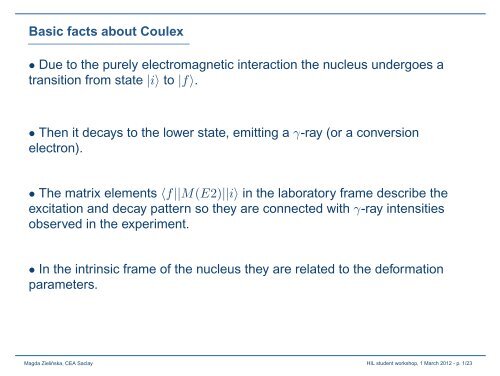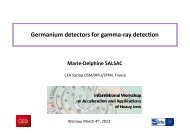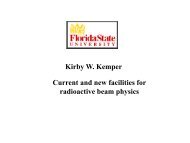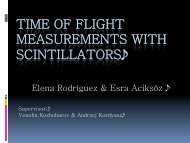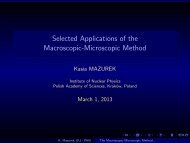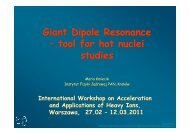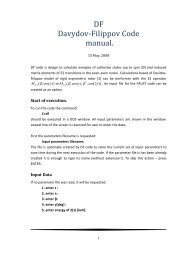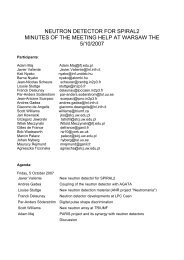Coulomb excitation
Coulomb excitation
Coulomb excitation
You also want an ePaper? Increase the reach of your titles
YUMPU automatically turns print PDFs into web optimized ePapers that Google loves.
Basic facts about Coulex• Due to the purely electromagnetic interaction the nucleus undergoes atransition from state |i〉 to |f〉.• Then it decays to the lower state, emitting a γ-ray (or a conversionelectron).• The matrix elements 〈f||M(E2)||i〉 in the laboratory frame describe the<strong>excitation</strong> and decay pattern so they are connected with γ-ray intensitiesobserved in the experiment.• In the intrinsic frame of the nucleus they are related to the deformationparameters.Magda Zielińska, CEA Saclay HIL student workshop, 1 March 2012 - p. 1/23
Basic facts about Coulex experiments• Due to the purely electromagnetic interaction the nucleus undergoes atransition from state |i〉 to |f〉.→ Cline’s "safe energy" criterion – if the distance between nuclear surfacesis greater than 5 fm, the nuclear interaction is negligible.• Then it decays to the lower state, emitting a γ-ray (or a conversionelectron).• The matrix elements 〈f||M(E2)||i〉 in the laboratory frame describe the<strong>excitation</strong> and decay pattern so they are connected with γ-ray intensitiesobserved in the experiment.• In the intrinsic frame of the nucleus they are related to the deformationparameters.Magda Zielińska, CEA Saclay HIL student workshop, 1 March 2012 - p. 2/23
Basic facts about Coulex experiments• Due to the purely electromagnetic interaction the nucleus undergoes atransition from state |i〉 to |f〉.→ Cline’s "safe energy" criterion – if the distance between nuclear surfacesis greater than 5 fm, the nuclear interaction is negligible.• Then it decays to the lower state, emitting a γ-ray (or a conversionelectron).→ gamma detectors needed• The matrix elements 〈f||M(E2)||i〉 in the laboratory frame describe the<strong>excitation</strong> and decay pattern so they are connected with γ-ray intensitiesobserved in the experiment.• In the intrinsic frame of the nucleus they are related to the deformationparameters.Magda Zielińska, CEA Saclay HIL student workshop, 1 March 2012 - p. 3/23
Basic facts about Coulex experiments• Due to the purely electromagnetic interaction the nucleus undergoes atransition from state |i〉 to |f〉.→ Cline’s "safe energy" criterion – if the distance between nuclear surfacesis greater than 5 fm, the nuclear interaction is negligible.• Then it decays to the lower state, emitting a γ-ray (or a conversionelectron).→ gamma detectors needed• The matrix elements 〈f||M(E2)||i〉 in the laboratory frame describe the<strong>excitation</strong> and decay pattern so they are connected with γ-ray intensitiesobserved in the experiment.→ to properly describe the <strong>excitation</strong> process - particle detectors needed• In the intrinsic frame of the nucleus they are related to the deformationparameters.Magda Zielińska, CEA Saclay HIL student workshop, 1 March 2012 - p. 4/23
}Why do we like <strong>Coulomb</strong> <strong>excitation</strong>?• it’s a very precise tool to measure the collectivity of nuclear <strong>excitation</strong>s andin particular nuclear shapes• shape = fundamental property of a nucleus, "condensed" informationabout its structure• <strong>excitation</strong> mechanism purely electromagnetic, the only nuclear propertiesinvolved: matrix elements of electromagnetic multipole operators• nuclear structure information extracted in a model-independent way-22∆t=2 . 10 s~20 fm238 U40 ArMagda Zielińska, CEA Saclay HIL student workshop, 1 March 2012 - p. 5/23
<strong>Coulomb</strong> <strong>excitation</strong> method• Cline’s ”safe energy” criterion: purely electromagnetic interaction if thedistance between nuclear surfaces is greater than 5 fm• The observed <strong>excitation</strong> depends on:◦ (Z, A) of the collision partners,◦ beam energy,◦ scattering angle.d = 1.25 · (A 1/3p + A 1/3t ) + 5.0 [fm]Magda Zielińska, CEA Saclay HIL student workshop, 1 March 2012 - p. 6/23
Magda Zielińska, CEA Saclay HIL student workshop, 1 March 2012 - p. 9/23
Magda Zielińska, CEA Saclay HIL student workshop, 1 March 2012 - p. 10/23
Validity of classical <strong>Coulomb</strong> trajectories• η » 1 required for a semiclassicaltreatment of equations of motion→hyperbolic trajectories• condition well fulfilled in heavy-ioninduced <strong>Coulomb</strong> <strong>excitation</strong>• semiclassical treatment is expectedto deviate from the exact calculationby terms of the order ≈ 1/ηMagda Zielińska, CEA Saclay HIL student workshop, 1 March 2012 - p. 11/23
Magda Zielińska, CEA Saclay HIL student workshop, 1 March 2012 - p. 12/23
Magda Zielińska, CEA Saclay HIL student workshop, 1 March 2012 - p. 13/23
Magda Zielińska, CEA Saclay HIL student workshop, 1 March 2012 - p. 14/23
Magda Zielińska, CEA Saclay HIL student workshop, 1 March 2012 - p. 15/23
Stable beam experiments• usually multi-step <strong>excitation</strong> and complicated level schemes• for deformed nuclei it may be useful to couple all matrix elements insideeach rotational band• beam intensities of the order of 10 9 pps: particle detectors at backwardangles• lifetime of several states known: no need for other kind of normalisation• statistics enough for particle-gamma angular correlations10dσ/dΩ (b/sr)10.12 1+4 1+6 1+0.01A B C D0 30 60 90 120 150 180θ c.m.(deg)Magda Zielińska, CEA Saclay HIL student workshop, 1 March 2012 - p. 16/23
Exotic beam experiments• usually one- or two-step <strong>excitation</strong>; level schemes not well known• beam intensities rather low: particle detectors at forward angles tomaximise the statistics• normalisation to target <strong>excitation</strong>• low statistics, sometimes only one gamma line observed• relative normalisation of different ranges of scattering angles based onRutherford scattering or target <strong>excitation</strong>CD detector44ArEXOGAMMagda Zielińska, CEA Saclay HIL student workshop, 1 March 2012 - p. 17/23
B(E2)’s in radioactive nuclei measured with Coulex• usually only 2 + → 0 + transition visible• normalisation to target <strong>excitation</strong> neededCounts / 2 keV103Ag109AgAg109109Ar+→ 02 + +0〈2 + ‖E2‖0 + 〉 2∼ B(E2; 2 + → 0 + )210Ag10944+2210-1-2102 + +010 500 1000 1500 2000 2500 3000Energy [keV]〈2 + ‖E2‖2 + 〉 ∼ Q 0• Coulex cross-section depends both on the B(E2;2 + 1 →0+ ) and thequadrupole moment!Magda Zielińska, CEA Saclay HIL student workshop, 1 March 2012 - p. 18/23
Reorientation effect• influence of the quadrupole moment of the excited state on its <strong>excitation</strong>cross-section• dependence on scattering angle and beam energy• BE CAREFUL – influence of double-step <strong>excitation</strong> of higher states mayhave the same effect!dσ / d Ω [b/sr]+20.030.020.01prolate, ME000 20 40 60 80 100 120 140LAB scattering angle [deg.]Relative population of the 0 state+20.050.0450.040.0350.030.025diagonal matrix element-0.9 eb0.0 eb+0.9 eb0.02110 115 120 125 130 135 140 145 150 155laboratory theta angleMagda Zielińska, CEA Saclay HIL student workshop, 1 March 2012 - p. 19/23
<strong>Coulomb</strong> <strong>excitation</strong> and lifetime measurements6 17820 165411988 27499677684 10145582 4564560 012022112120274650891069474 Kr42017411233 1285• results inconsistent withpreviously published lifetimes• new RDM lifetimemeasurement:Köln Plunger & GASP40 Ca ( 40 Ca,α2p) 74 Kr40 Ca ( 40 Ca,4p) 76 Kr2• subdivision of data in several ranges ofscattering angle• spectroscopic data (lifetimes, branchingand mixing ratios)• least squares fit of ∼30 matrix elements(transitional and diagonal)N γ/ N Kr0.080.070.060.050.040.030.020.012 1+4 1+old τ020 30 40 50 60 70θ c.m.(deg)Magda Zielińska, CEA Saclay HIL student workshop, 1 March 2012 - p. 20/23
Lifetime measurement A. Görgen et al. EPJ A 26 153 (2005)76 Krold new old new2 + 35.3(10) ps 41.5(8) ps 74 Kr 2 + 28.8(57) ps 33.8(6) ps4 + 4.8(5) ps 3.87(9) ps 4 + 13.2(7) ps 5.2(2) ps74 Kr, forward detectors (36 ◦ )gated from above80060040020001000500060040020002 + 80216 µm 4 + 50 µm 6 + 7.5 µm1500601000400.040.03500200.0200400 µm99 µm18 µm300400.013020020020 30 40 50 60 70800 µm455.7440 450 460 470 480E γ[keV]1000200150100500550 560 570 580 590E γ[keV]10216 µm 25 µm80557.906040200768.4760 770 780 790 800E γ[keV]N γ/ N Kr0.080.070.060.052 1+4 1+new τθ c.m.(deg)• new lifetimes in agreement with Coulex• enhanced sensitivity for diagonal andintra-band transitional matrix elementsMagda Zielińska, CEA Saclay HIL student workshop, 1 March 2012 - p. 21/23
Results: shape coexistence in light Kr isotopes76 Kr: 18 transitional + 5 diagonal ME74 Kr: 14 transitional + 5 diagonal ME〈2 + 1 ‖E2‖2+ 1 〉 = – 0.70−0.33 −0.30〈4 + 1 ‖E2‖4+ 1 〉 = – 1.02+0.59 −0.21〈2 + 2 ‖E2‖2+ 2 〉 = + 0.33+0.28 −0.236 17820 165411988 27499677684 10145582 4564560 012022112120274650891069442017411233 12852N γ(I π ) / N γ(2 1+→01+)N γ(2 2+→21+) / Nγ (2 1+→01+)0.60.50.40.30.20.100.060.040.020exp. 4 1+→21+fit (ME < 0)fit (ME > 0)exp. 6 1+→41+fit (ME < 0)experimentfit (ME > 0)30 60 90 120 150θ c.m.(deg)First measurement of diagonal E2 matrix elements using Coulex of radioactive beamE. Clément et al. Phys. Rev. C75, 054313 (2007)Magda Zielińska, CEA Saclay HIL student workshop, 1 March 2012 - p. 22/23
Gamma-particle angular correlations• feasible at several thousands of counts in a given gamma line• determination of E2/M1 mixing ratios• determination of spin of a decaying level• distribution in phi usually more conclusive than in thetaMagda Zielińska, CEA Saclay HIL student workshop, 1 March 2012 - p. 23/23


